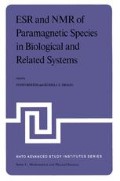Abstract
The binding and activation of dioxygen is essential to many biological functions. Cobalt(II) complexes reversibly bind O2 and the resulting adducts have one unpaired electron. The presence of an odd electron in these complexes affords a ready probe of the electronic structure of the O2 adduct by electron paramagnetic resonance spectroscopy. This feature and the relative stability of the cobalt(II) complexes has stimulated considerable research on the cobalt (II) system. Early interpretations of epr, X-ray diffraction and infrared results on these dioxygen adducts of cobalt (II) are classic cases of over-interpretation of data. The topic will be developed historically and the objective of this school will be to learn the lessons from the past so they will not be repeated.
Access this chapter
Tax calculation will be finalised at checkout
Purchases are for personal use only
Preview
Unable to display preview. Download preview PDF.
References
McGarvey, B.R.: 1975, Can. J. Chem. 53, p. 2498.
Hoffman, B.M., Diemente, D.L., and Basolo, F.: 1970, J. Am. Chem. Soc. 92, p. 61.
Melamud, E., Silver, B.L., and Dori, Z.: 1974, J. Am. Chem. Soc. 96, p. 4689.
Basolo, F., Hoffman, B.M., and Ibers, J.A.: 1975, Ace. Chem. Res. 8, p. 384.
Drago, R.S.: 1979, Inorg. Chem. 18, p. 1408.
Chien, J.C.W. and Dickinson, L.C.: 1972, Proc. Nat. Acad. Sci. 69, p. 2783.
Getz, D., Melamud, E., Silver, B.L., and Dori, Z.: 1975, J. Am. Chem. Soc. 97, p. 3846.
Tovrog, B.S., Kitko, D.J., and Drago, R.S.: 1975, J. Am. Chem. Soc. 98, p. 5144.
Drago, R.S. and Corden, B.B.: 1980, submitted, p. 000.
McConnell, H.M. and Chestnut, D.B.: 1958, J. Chem. Phys. 28, p. 107.
Cramer, R.E. and Drago, R.S.: 1968, J. Am. Chem. Soc. 90, p. 4790.
Drago, R.S. and Petersen, H.: 1967, J. Am. Chem. Soc. 89, p. 3978.
Symons, M.C.R. and Wilkinson, J.G.: 1972, J. Chem. Soc. 68, Faraday Trans. II, p. 1265.
Fantucci, P. and Valenti, V.: 1976, J. Am. Chem. Soc. 98, p. 3832.
Redieu, A., Rohmer, M.-M., Bernard, M., and Veillard, A: 1976, J. Am. Chem. Soc. 98, p. 3717.
Drago, R.S., Beugelsdijk, T., Bréese, J.A., and Cannady, J.P.: 1978, J. Am. Chem. Soc. 100, p. 5374.
Perutz, M.F.: 1976, Br. Med. Bull.32, p. 195 and references therein.
Imai, K., Yonetani, T., and Ikeda-Saito, M: 1977, J. Mol. Biol. 109, p. 83 and references therein.
Author information
Authors and Affiliations
Editor information
Editors and Affiliations
Rights and permissions
Copyright information
© 1980 D. Reidel Publishing Company, Dordrecht, Holland
About this paper
Cite this paper
Drago, R.S. (1980). The Spin-Pairing Model for the Binding of Dioxygen to Transition Metal Complexes. In: Bertini, I., Drago, R.S. (eds) ESR and NMR of Paramagnetic Species in Biological and Related Systems. Nato Advanced Study Institutes Series, vol 52. Springer, Dordrecht. https://doi.org/10.1007/978-94-009-9524-6_13
Download citation
DOI: https://doi.org/10.1007/978-94-009-9524-6_13
Publisher Name: Springer, Dordrecht
Print ISBN: 978-94-009-9526-0
Online ISBN: 978-94-009-9524-6
eBook Packages: Springer Book Archive

